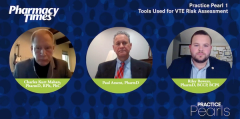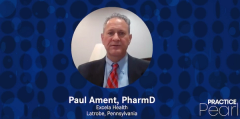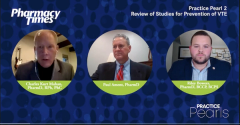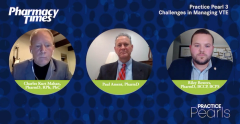
Practice Pearl 3: Dosage Forms of Treatment for VTE Prevention
Experts in the management of VTE discuss the deterrents among providers, patients, and pharmacists, specifically looking at the various dosage forms of treatment.
Episodes in this series

Experts in the management of VTE discuss the deterrents among providers, patients, and pharmacists, specifically looking at the various dosage forms of treatment.
Charles Kurt Mahan, PharmD, RPh, PhC: Let’s shift for our last topic to Practice Pearl® No. 3, which is managing challenges in the prevention of VTE [venous thromboembolism]. Let’s talk about some of the barriers and deterrents among providers, patients, and pharmacists with regard to extended prophylaxis with DOACs [direct oral anticoagulants]. How can we improve this education? What are your roles? For injectables, are there any advantages of the orals over the injectables?
Paul Ament, PharmD: The main deterrent is that clinicians will go to treatment guidelines that show that the extended prophylaxis is not recommended, so the FDA indications are further ahead than what we have with treatment guidelines. I tried to explain that, with the study designs, for a majority of time of almost 3 to 4 weeks, anticoagulation therapy with betrixaban and rivaroxaban was being compared with placebo.
The enoxaparin run-in was usually only about 7 to 10 days, so of course you’re going to see some higher bleeding rates when you’re comparing anticoagulation with placebo. When you look at fatal bleeds, there was almost the same number of fatal bleeds in the placebo group as with the anticoagulation group, so getting that education out is very important. I will still say, though, that I don’t know exactly what that high-risk patient looks like. Is it a patient who’s has had a history of clotting, obesity, an age over 75 years, congestive heart failure, or cellulitis?
I’m still struggling with what that patient looks like. A poll out of the American Journal of Health-System Pharmacy a few years ago looked at missed medications or nonadministered medications. What this study showed is that, when you’re looking at subcutaneous anticoagulants, the nonadministered medication rate was double what it was for oral therapy, so patients are refusing the injections. When we took the medically ill indication to our P&T [pharmacy and therapeutics committee] meeting for Xarelto [rivaroxaban] to be added to our order sets, we had nursing represented on the P&T committee with 3 frontline nurses.
I presented the clinical data and was excited. They basically took over and said, “Patients are refusing the subcutaneous injections. They’re painful. They cause bruising. Patients don’t recognize the importance of it. If you give me an oral option, these patients are going to want to use it and be more agreeable to it.” The frontline nurses sold the addition of Xarelto [rivaroxaban] to our order sets for VTE prophylaxis.
Riley Bowers, PharmD, BCCP, BCPS: That’s a great point. There’s some real practical benefit in using oral agents in place of injectables in that extended prophylaxis interval that is extremely hard to capture in a clinical trial setting.
The other thing I wanted to circle back to is the education component. Part of the reason for the lack of utilization of these agents in the extended prevention role is a lack of education. Something that I have found out well as a faculty member who practices in the hospital setting is that using a bottom-up approach can work really well when I need to educate large groups in a short amount of time. What I mean by that is this: If you start with the students and residents in pharmacy and medical, you can capture a lot of people in 1 setting and have them help disseminate that information.
Newsletter
Stay informed on drug updates, treatment guidelines, and pharmacy practice trends—subscribe to Pharmacy Times for weekly clinical insights.


















